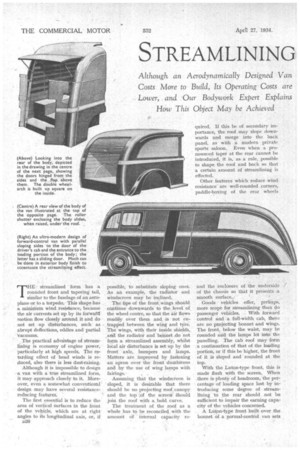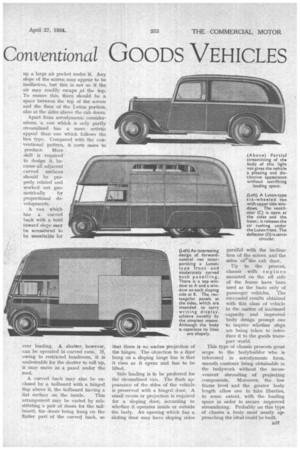STREAMLINING
Page 92

Page 93

If you've noticed an error in this article please click here to report it so we can fix it.
Conventional GOODS VEHICLES THE streamlined form has a rounded front and tapering tail, similar to the fuselage of an aeroplane or to a. torpedo. This shape has a minimufn wind resistance, because the air currents set up by its forwafd motion flow closely around it and do not set up disturbances, such as abrupt deflections, eddies and partial 'vacuums.
. The practical advantage of streamlining is economy of engine power, • particularly at high speeds. The retatding effect of head winds is reduced, also there is less dust-raising. Although it is impossible to design -a van with a true streamlined form, it may approach closely to it. Moreover, even a somewhat conventionnl • design may have several resistancereducing features.
The first essential is to reduce the area of vertical surfaces in the front of the vehicle, which are at right angles to its longitudinal axis, or, if possible, to substitute sloping ones. As an example, the radiator and windscreen may be inclined.
The tips of the front wings should continue downwards to the level of the wheel centre, so that the air flows readily over them and is not entrapped between the wing and tyre. The wings, with their inside shields, ,and the radiator and bonnet ,do not form a streamlined assembly, whilst local air disturbance is set up by the front axle, bumpers and lamps. Matters are improved by fastening an apron over the front dumbirons and by the use of wing lamps with fairings.
Assuming that the windscreen is ' sloped, it is desirable that there should be no projecting roof canopy and the top .of the screen, §hould join the roof with a bold curve.
The treatment of the roof as a whole has to be reconciled with the amount of internal capacity re
and the enclosure of the underside of the chassis so that it presents a smooth surface.
Goods vehicles offer, perhaps, more scope for streamlining than do
passenger vehicles. With forward control and a full-width cab, ther are no projecting bonnet and wings. The front, below the waist, may be rounded and the lamps let into the panelling. The cab roof may form a continuation of that of the loading portion, or if this be higher, the front of it is sloped and rounded at the top.
With the Luton-type front, this is made flush with the screen. When there is plenty of headroom; the percentage of loading space lost by introducing some degree of streamlining to the rear should not be sufficient to impair the earning capacity of the vehicles concerned.
A Lukon-type front built over the bonnet of a normal-control van sets rear loading. A. shutter, however, can be operated in curved runs. If, owing to restricted headroom, it is undesirable for the shutter to roll up, it may move as a panel under the roof.
A curved back may also be enclosed by a tailboard with a hinged flap above it, the tailboard having a flat surface on the inside. This arrangement may be varied by substituting a pair of doors for the tailboard, the doors being hung on the flatter part of the curved back, so that there is no undue projection of the hinges. The objection to a door hung on a sloping hinge line is that it rises as it opens and has to be Side loading is to be preferred for the streamlined van. The flush appearance of the sides of the vehicle is preserved with a hinged door. A small recess or projection is required for a sloping door, according to whether it operates inside or outside the body. An opening which has a sliding door may have sloping sides parallel with the inclination of the screen and the sides ofVthe cab door.
Up to the present, chassis with engines mounted on the off side of the frame have been used as the basis only of passenger vehicles. The successful results obtained with this class of vehicle in the matter of increased capacity and improved body design prompt one to inquire whether steps are being taken to introduce it to the goods transport world.
This type of chassis presents great scope to the bodybuilder who is interested . in aerodynamic form, smooth contours being obtainable in the bodywork without the inconvenient shrouding of projecting components. Moreover, the low frame level and the greater body length allow one to fake liberties, to some extent, with the loading space in order to secure improved streamlining. Probably on this type of chassis a body most nearly approaching the ideal could be built.




















































































































































































